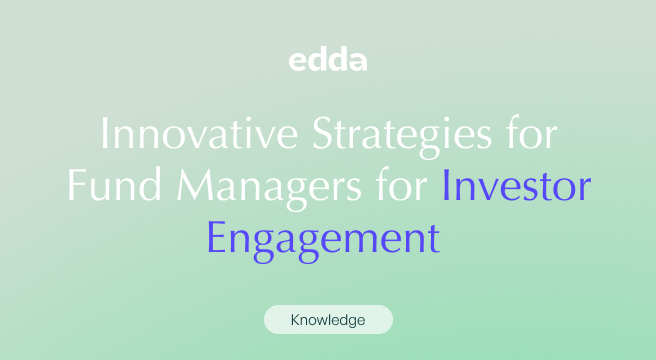The changing environment of venture capital (VC) in 2024 presents a unique set of opportunities for investors and startups. These trends are likely to impact investment strategies and opportunities for innovation in the coming years – so keeping pace is essential for VCs.
This article will explore the key trends expected to shape the venture capital industry in 2024. From the rise of mega-deals and the expansion of equity crowdfunding to the geographic diversification of investments and the growing importance of data in decision-making, we will provide a detailed look at the forces driving change in venture capital.
In addition, discover how Edda’s VC deal flow management software for venture capital can help you manage the entire investment lifecycle.
The Rise in High-Value Investment Deals
The venture capital arena has seen an accelerating trend toward high-value investment deals, a movement characterized by a growing number of startups reaching and surpassing the billion-dollar valuation mark, known as “unicorns.”
This trend, extending into “hectocorns” (companies valued at over $100 billion) and “decacorns” (valued at over $10 billion), is reshaping the investment landscape. These mega-deals represent a strategic belief in the startups’ potential to redefine their sectors, drive innovation, and capture significant market share.
Venture capitalists are increasingly willing to place substantial bets on startups they believe have the potential to dominate their respective markets.
For example, SpaceX’s ascent to a “hectocorn” status, with valuations surpassing $100 billion, exemplifies the transformative impact of high-value venture capital deals. Founded by Elon Musk in 2002, SpaceX revolutionized space transportation with its reusable rocket technology, attracting significant investments, including a notable $1 billion from Google and Fidelity in 2015.
This infusion of capital propelled the company through groundbreaking achievements, such as the first privately funded spacecraft to reach orbit and dock with the International Space Station. SpaceX’s success story highlights how substantial venture investments can drive technological breakthroughs and yield substantial returns, underscoring the potential of high-value deals.
The allure of backing the next market leader is compelling, offering the promise of substantial returns. This is particularly evident in sectors fueled by breakthrough technologies and disruptive business models, where the scale and speed of growth can be exponential. However, this rush towards high-value deals also brings to light concerns regarding market concentration and the equitable distribution of capital.
As more funds are channeled into a select group of high-potential startups, there’s a risk that smaller, albeit innovative, ventures might struggle to secure the investment they need to thrive. This could lead to a less diverse startup ecosystem, where only those with the most immediate scale-up potential receive the necessary backing, potentially stifling innovation in other areas.
The capacity to discern which startups possess the ingenuity, market positioning, and leadership to reach these high valuations becomes increasingly vital. Venture capitalists and investors are refining their evaluation criteria, leaning heavily on data analytics, market trends, and the scalability of business models to inform their decisions.
Democratization Through Equity Crowdfunding
Equity crowdfunding is significantly democratizing access to venture investments. This trend is set to continue into 2024, reshaping how startups secure funding and how individuals can participate in venture capital. Traditionally, venture capital has been the domain of accredited investors and institutions, but equity crowdfunding platforms have opened the doors for a broader audience to invest in startups, often with as little as a few hundred dollars.
Platforms like Kickstarter and Indiegogo initially popularized the concept of crowdfunding by allowing individuals to support projects in exchange for rewards. This has evolved into equity crowdfunding, where backers receive equity in the startup. This shift has been facilitated by regulatory changes, such as the JOBS Act in the United States, which relaxed securities regulations to allow non-accredited investors to participate in equity crowdfunding.
The impact of this trend is twofold. For startups, it provides an alternative route to raise capital beyond traditional venture capital firms, potentially easing the fundraising process and offering a wider base of support. For the public, it democratizes investment opportunities that were previously out of reach, enabling more people to invest in early-stage companies and potentially benefit from their growth.
Venture capitalists can effectively leverage the trend of equity crowdfunding in several strategic ways to enhance their investment approach and portfolio performance in 2024:
Diversification of Investment Sources: Venture capitalists can use equity crowdfunding as a complementary investment channel to traditional funding rounds. By participating in crowdfunding campaigns, VCs can diversify their investment sources and reduce risk by spreading capital across a broader range of opportunities.
Early Detection of Emerging Trends: Equity crowdfunding platforms can serve as a barometer for consumer interest and market trends. VCs can monitor these platforms to identify startups that are gaining traction among a wide investor base, potentially uncovering promising opportunities early in their growth journey.
Synergistic Investments: VCs can look for synergies between their existing portfolio companies and startups raising funds through equity crowdfunding. By investing in these complementary businesses, VCs can foster collaboration, drive innovation, and create additional value within their portfolio.
Building Community & Brand Equity: By supporting equity crowdfunding campaigns, VCs can engage with the broader startup and investor community, enhancing their brand visibility and reputation. This engagement can also provide valuable insights into consumer and investor sentiment, informing future investment strategies.
Leveraging Data for Due Diligence: Equity crowdfunding platforms generate vast amounts of data on startup performance, investor behavior, and market trends. VCs can leverage this data to enhance their due diligence processes, making more informed investment decisions based on comprehensive market intelligence.
Post-Investment Support & Scaling: Venture capitalists can offer more than just capital to startups funded through equity crowdfunding. By providing mentorship, strategic guidance, and access to their networks, VCs can help these startups scale effectively, potentially leading to higher returns on their investments.
Geographic Expansion & Diversification
This movement marks a major shift from the traditional concentration of venture capital in tech-centric hubs like Silicon Valley. Venture capitalists are increasingly casting their nets wider, using venture capital software to explore opportunities in emerging markets and regions previously underserved by venture funding.
This geographic diversification is driven by several key factors:
Technological Globalization: The digital era has democratized access to technology, enabling startups from various parts of the world to innovate and compete on a global scale. This has opened up new investment frontiers for venture capitalists beyond traditional tech hubs.
Market Potential in Emerging Economies: High-growth markets in Asia, Africa, and Latin America are attracting venture capitalists due to their burgeoning middle classes, increasing internet penetration, and untapped market potential. Startups in these regions are addressing unique local challenges, presenting novel investment opportunities.
Remote Work & Operations: The rise of remote work, accelerated by recent global events, has proven that companies can operate and scale without being anchored to traditional tech epicenters. This realization has encouraged VCs to invest in startups operating in diverse geographic locations.
Competitive Advantage: Investing in diverse markets allows venture capitalists to achieve a competitive edge by tapping into local knowledge, networks, and innovation ecosystems. This can lead to the discovery of unique investment opportunities that might be overlooked by those focusing solely on established markets.
Risk Mitigation: Geographic diversification also serves as a risk management strategy, allowing VCs to spread their investments across different markets and reduce exposure to regional economic fluctuations.
For venture capitalists looking to capitalize on this trend, the key lies in developing a deep understanding of local markets, cultures, and regulatory environments. Building partnerships with local investors, incubators, and accelerators can provide valuable insights and access to promising startups. Additionally, leveraging technology to manage and support a geographically dispersed portfolio will be crucial for success.
Leveraging Public Web Data for Investment Insights
Venture capitalists are increasingly harnessing the power of public web data to inform their investment strategies. This trend signifies a departure from reliance solely on traditional financial metrics and due diligence processes.
Instead, VCs are integrating diverse data sources such as social media analytics, consumer sentiment analysis, online traffic and engagement metrics, and competitive landscape data to gain a more nuanced understanding of a startup’s potential and market dynamics.
The strategic use of public web data offers several advantages:
Enhanced Due Diligence: By analyzing data from a variety of online sources, VCs can obtain a more comprehensive view of a startup’s performance, brand strength, customer loyalty, and market position. This multi-dimensional analysis aids in identifying both opportunities and red flags that may not be evident through traditional evaluation methods.
Market Trend Analysis: Public web data provides real-time insights into emerging trends, consumer behaviors, and evolving market needs. Venture capitalists can leverage this information to identify sectors that are gaining momentum and startups that are well-positioned to capitalize on these trends.
Competitive Intelligence: Understanding the competitive landscape is crucial for assessing a startup’s potential for success. Public web data allows VCs to monitor competitors’ activities, market share, and customer feedback, providing a clearer picture of the startup’s competitive advantage and potential challenges.
Predictive Analytics: Advanced analytics and machine learning models can process vast amounts of public web data to predict future trends, startup growth trajectories, and potential market disruptions. These predictive insights can inform more proactive and strategic investment decisions.
Portfolio Monitoring: For VCs managing a portfolio of investments, public web data offers a tool for continuous monitoring of portfolio companies’ online presence, customer engagement, and market perception. This ongoing analysis can highlight successes to be replicated or issues that need addressing.
As venture capitalists look to 2024 and beyond, effectively leveraging public web data will become increasingly integral to maintaining a competitive edge. This requires the ability to collect and analyze large datasets as well as the expertise to interpret this data within the context of broader market trends and individual startup dynamics.
Embracing this trend, venture capitalists can make more informed, data-driven decisions to reduce investment risks and identify high-potential opportunities.
Commitment to Sustainable & Impactful Investing
The venture capital sector is increasingly prioritizing sustainable and impactful investing. A broader shift towards environmental, social, and governance (ESG) criteria is heavily influencing investment decisions. Venture capitalists are now more attuned to the long-term implications of their investments, focusing not only on financial returns but also on the positive impact on society and the environment.
Key drivers of this trend include:
Rising Consumer Awareness: As consumers become more environmentally and socially conscious, they prefer products and services from companies that reflect their values. Startups with strong ESG principles are likely to gain a competitive edge, attracting both customers and investors.
Regulatory Changes: Increasingly, governments worldwide are implementing regulations that encourage or mandate sustainable business practices. Startups that are ahead in adopting these practices may face lower regulatory risks and potentially benefit from incentives.
Long-term Value Creation: There’s a growing recognition that sustainable and impactful business models can lead to long-term value creation, reducing risks related to environmental and social issues. This aligns with the venture capital model of building enduring companies.
Innovation Opportunities: Many of the world’s most pressing challenges, such as climate change and inequality, also represent significant opportunities for innovation. Startups that address these challenges with scalable solutions can tap into large and growing markets.
Institutional Investor Influence: As institutional investors increasingly incorporate ESG criteria into their investment strategies, they exert pressure on venture capital firms to do the same. This is especially relevant for VCs that rely on institutional capital.
For venture capitalists, leveraging this trend might involve investing in clean energy technologies, sustainable agriculture, healthcare innovations, and other sectors that address critical global challenges.
In addition, VCs can play a crucial role in guiding their portfolio companies toward more sustainable and impactful business practices, helping them to integrate ESG principles into their operations and culture. This will both enhance the companies’ market positioning and result in broader societal benefits.
Embracing Technological Advancements
The venture capital industry continues to embrace technological advancements, recognizing their transformative potential across various sectors. This involves not only investing in technology-driven startups but also leveraging technology to enhance venture capital operations, decision-making, and portfolio management.
Key aspects of this trend include:
Fintech Innovation: The financial technology sector remains a hotbed for venture capital investment, with startups offering revolutionary solutions in payments, blockchain, insurtech, and robo-advisory services. These innovations are reshaping the financial landscape, providing venture capitalists with lucrative investment opportunities and tools to streamline their own operations.
AI & Machine Learning: Artificial intelligence and machine learning are becoming integral to venture capital firms, aiding in market analysis, investment screening, and predictive modeling. These technologies enable VCs to process vast amounts of data to uncover insights, identify trends, and make more informed investment decisions.
Remote Collaboration Tools: The widespread adoption of remote work has accelerated the use of collaboration tools and platforms within the venture capital community. These technologies facilitate seamless communication and collaboration between VCs and their portfolio companies, as well as among investment teams spread across different geographies.
Cybersecurity Ventures: As digital transformation accelerates, so does the need for advanced cybersecurity solutions. Venture capitalists are keenly investing in startups that offer innovative security technologies, recognizing the critical importance of protecting digital assets.
Healthtech & Biotech: The health sector’s rapid digitization, partly propelled by recent global health challenges, has opened up new avenues for venture capital investment. Startups leveraging telemedicine, wearable devices, personalized medicine, and digital health platforms are attracting significant VC interest, driven by their potential to revolutionize healthcare delivery.
Portfolio Diversification Strategies
Venture capitalists are broadening their investment horizons, not just across different sectors and stages of company growth, but also in terms of geographic reach and investment models. This diversification strategy is driven by the desire to mitigate risks and capitalize on a wider array of opportunities presented by global innovation and market dynamics.
Sectoral Diversification: While tech startups continue to attract significant venture capital, investors are increasingly exploring opportunities in non-traditional sectors such as edtech, agritech, and sustainable technologies. This sectoral diversification allows VCs to tap into emerging trends and innovations that address a broader set of global challenges and market needs.
Geographic Expansion: Mirroring the trend of geographic expansion in venture investments, portfolio diversification also involves looking beyond established innovation hubs. By investing in startups located in emerging markets or less traditional regions, VCs can access new talent pools, innovation ecosystems, and growth markets, further spreading risk and uncovering unique opportunities.
Stages of Investment: Diversifying across different stages of startup development, from seed to late-stage investments, allows venture capitalists to balance the risk and reward profile of their portfolios. While early-stage investments offer higher potential returns, they come with increased risk. Late-stage investments, conversely, tend to offer more stability and lower risk, albeit with potentially lower returns.
Investment Models: Venture capitalists are also exploring alternative investment models, such as revenue-based financing, venture debt, and hybrid models, to complement traditional equity investments. These models provide flexibility in how VCs support startups, allowing for tailored financing solutions that align with the specific needs and growth trajectories of portfolio companies.
Leveraging the Best CRM for Venture Capital
Embracing innovative tools and platforms like Edda’s CRM for venture capital becomes crucial for investors and startups navigating the changing tides of funding.
Edda’s venture capital CRM software, designed for the modern VC ecosystem, offers comprehensive solutions that align with the emerging trends highlighted in the article. From managing high-value investment deals with precision to leveraging data for informed decision-making and fostering sustainable, impactful investments, Edda’s software venture capital tools equip users with the capabilities to thrive amidst the shifting dynamics of venture capital.
ts intuitive platform facilitates efficient deal flow management, robust portfolio analysis, and seamless investor relations, ensuring that VCs and entrepreneurs are well-equipped to capitalize on the opportunities of tomorrow’s market.







